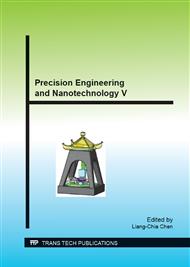p.14
p.20
p.26
p.34
p.42
p.47
p.53
p.60
p.66
Error Detection Technology for Calibrating Precision of Non-Contact Coordinate Measuring Machine
Abstract:
In this paper, a non-contact coordinate measuring machine with laser displacement sensor, which consists of three translational axes, is designed and built independently. In order to obtain the measuring precision, it needs to calibrate the coordinate measuring machine. Learning from the calibration method of contact coordinate measuring machine, a detection method is proposed for calibrating the precision of the non-contact coordinate measuring machine. Based on the homogeneous coordinate transformation theory, the error model of coordinate measuring machine is built under the condition that the positioning errors, angular errors, straightness errors and perpendicularity errors are taken into comprehensive consideration. The final error expressions of three axes can be calculated in the use of error model and homogeneous coordinate transformation theory. The final values of the errors are acquired through the analysis of the error curves, which can be obtained by using the laser interferometer system. The method proposed in this paper is using the two-dimensional ball plate to measure the errors. By locating three different positions of the ball plate in the space and using automatic centering procedure to measure the center position which is previously calibrated, the final errors of three axes can be detected directly. By comparing the two results, it testifies that the two-dimensional ball plate detection method is reasonable. Comparing with the laser interferometer method, the two-dimensional ball plate detection method reduces the workload of adjusting the optical path and the time of measuring errors, which has the vital significance in calibrating the precision of non-contact coordinate measuring machine.
Info:
Periodical:
Pages:
42-46
Citation:
Online since:
August 2014
Authors:
Price:
Сopyright:
© 2015 Trans Tech Publications Ltd. All Rights Reserved
Share:
Citation:


